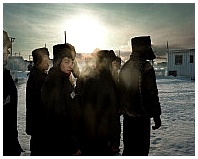
 Off to Camp in Siberia Between the 16th and 19th centuries, the non-indigenous populations of Siberia began to grow slowly, beginning with fur traders who came to the Arctic looking for sable pelts. But other people also began to take up residency in the Russian northern wilderness, although not very willingly. Under the rule of the Russian tsars, over a million prisoners were "exiled" to forced labor camps in Siberia. After the Russian Revolution the prison camps were closed down. However, they were later reopened by Joseph Stalin who got rid of people who opposed him by sending them off to what became known as Glavnoye Upravleniye Lagere - or "gulags". The camps were horrendous places. Located in north-eastern Siberia, temperatures could drop to almost -90.4°F / -68°C degrees during the winter. Proper care of prisoners was not a high priority, and it was not unusual for up to 30% of the inmates to die each year.
Click pictures for more information and credits. Library: Countries, Eurasia, Arctic Links: Cold Places, Arctic Arctic Maps & Weather Reports |

|
DICTIONARY: Just "double-click" any unlinked word on this page for the definition from Merriam-Webster's Student Electronic Dictionary at Word Central. |

|
ARCTIC LIBRARY & GLOSSARY: Check this section for an index of the rest of the things you really need to know about the Arctic. |

|
ARCTIC MAPS & WEATHER REPORTS: Maps of the Northwest Passage, explorers' routes, iceberg sources, Nunavut, the Arctic by treeline, temperature... |

|
ARCTIC LINKS: Even more information! Links to sites related to the Arctic and "Iceberg: the Story of the Throps and the Squallhoots". |

|
GUIDE TO ARCTIC SUNRISE & SUNSET: How much sunlight or darkness is there in the Arctic on each day of the year? |
to is the property of their respective owners, and Athropolis is not responsible for their content.